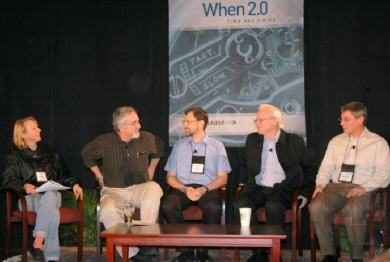When 2.0: Bring on calendar interoperability

The When 2.0 workshop, led by Esther Dyson, kicked off this morning on the campus of Stanford University. It's a small smallish group, less than a hundred 165 people, many with calendar-based products and an interest in time as a underpowered data type in applications. As is generally the case with software, calendars are tethered to specific platforms, which makes it difficult to ensure interoperability.
During a panel discussion, the participants (see below) pointed to the need for standards to the resolve the complexity and clunkiness of sharing and co-editing calendar information. "Each [calendar] has its own APIs and code bases, but we have to figure out how to share," said Microsoft CTO Ray Ozzie.

From left: Esther Dyson, Mitchell Kapor, Open Source Application Foundation; Yori Nelken, TimeBridge; Ray Ozzie, Microsoft; Raymie Stata, Yahoo
During his first few weeks at Microsoft Ozzie said he met with various groups at Microsoft with calendaring/time-based functions and came up with the notion that vcards for contacts and iCal for individual events or meetings should be packaged in RSS feeds and then published as categories of entries." The next step, he said, is figuring out how to swap and co-edit, which is where is Simple Sharing Extensions (SSE) fits in, cross linking feeds, editing and swaping data bidirectionally.
"Standards will free up developers from reinventing the wheel," said Mitchell Kapor, a founder of the non-profit Open Source Applications Foundation (OSAF) and Ozzie's former partner at Lotus Development (Ozzie led the team that developed Lotus Notes). "iCal is fine for data presentation of an event, but when attempting to coordinate a collection of events among multiple computers, there are SSE and CalDAV, a protocol for allowing calendar access via WebDAV, to the extent we have agreement and compliant systems."
The idea is that email/calendar stacks (such as Microsoft's Exchange server, MAPI protocol, Outlook interface or OSAF's Cosmo server, CalDAV protocol and Chandler interface) could use SSE for exchanging and synching calendar information between repositories (servers) bidirectionally.
After the panel Ozzie, Kapor and Lisa Dusseault, who published the CalDAV spec in 2003, were sitting around a table outside in the nippy Northern California air, presumably discussing standards issues and the combination of CalDAV and SSE. I asked Ozzie after the conversation finished for a summary. He said the talks were preliminary and that there was "nothing mutually exclusive in the things we were talking about. It's in all of our best interests to get calendar interoperability," he said.
It doesn't appear that the technical hurdles to calendar sharing and interoperability are overwhelming, but clearly the politics and desire from some parties to create their own 'de facto' standards is holding back progress...